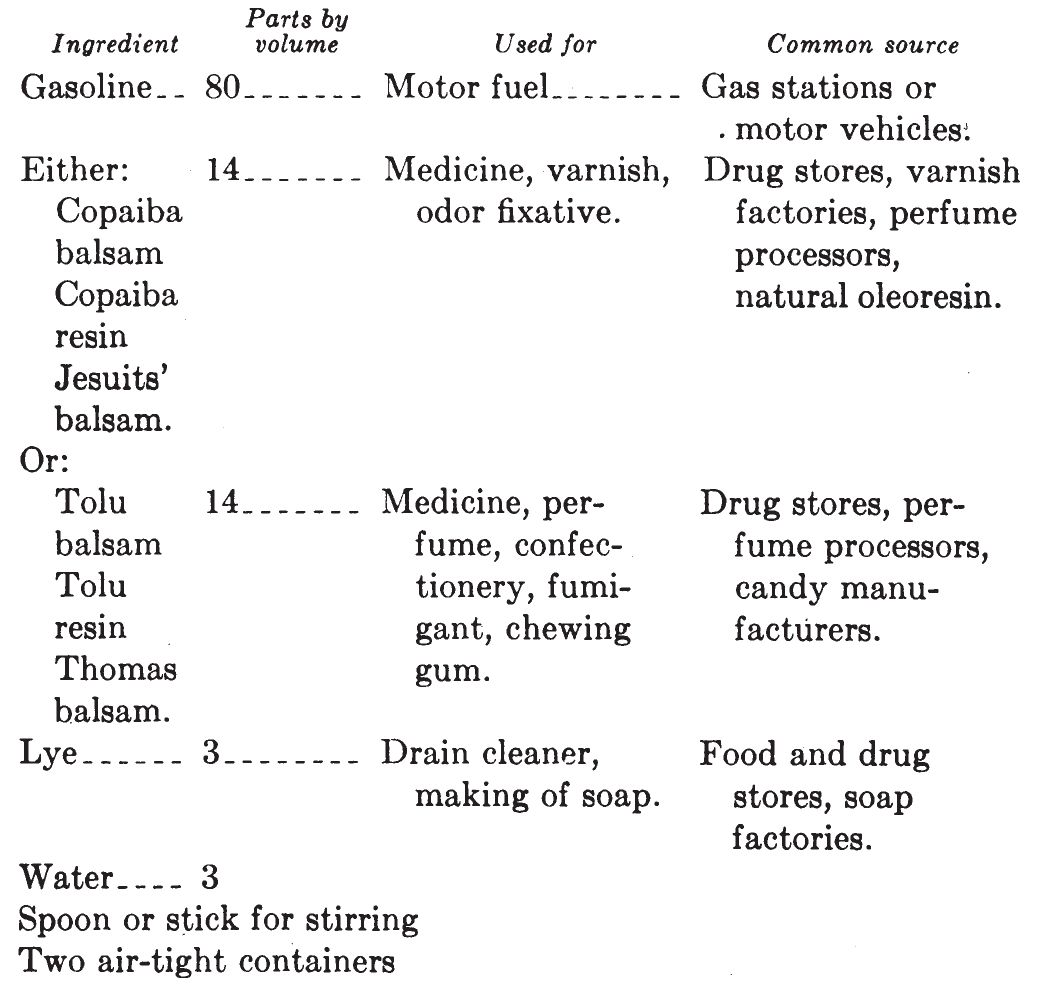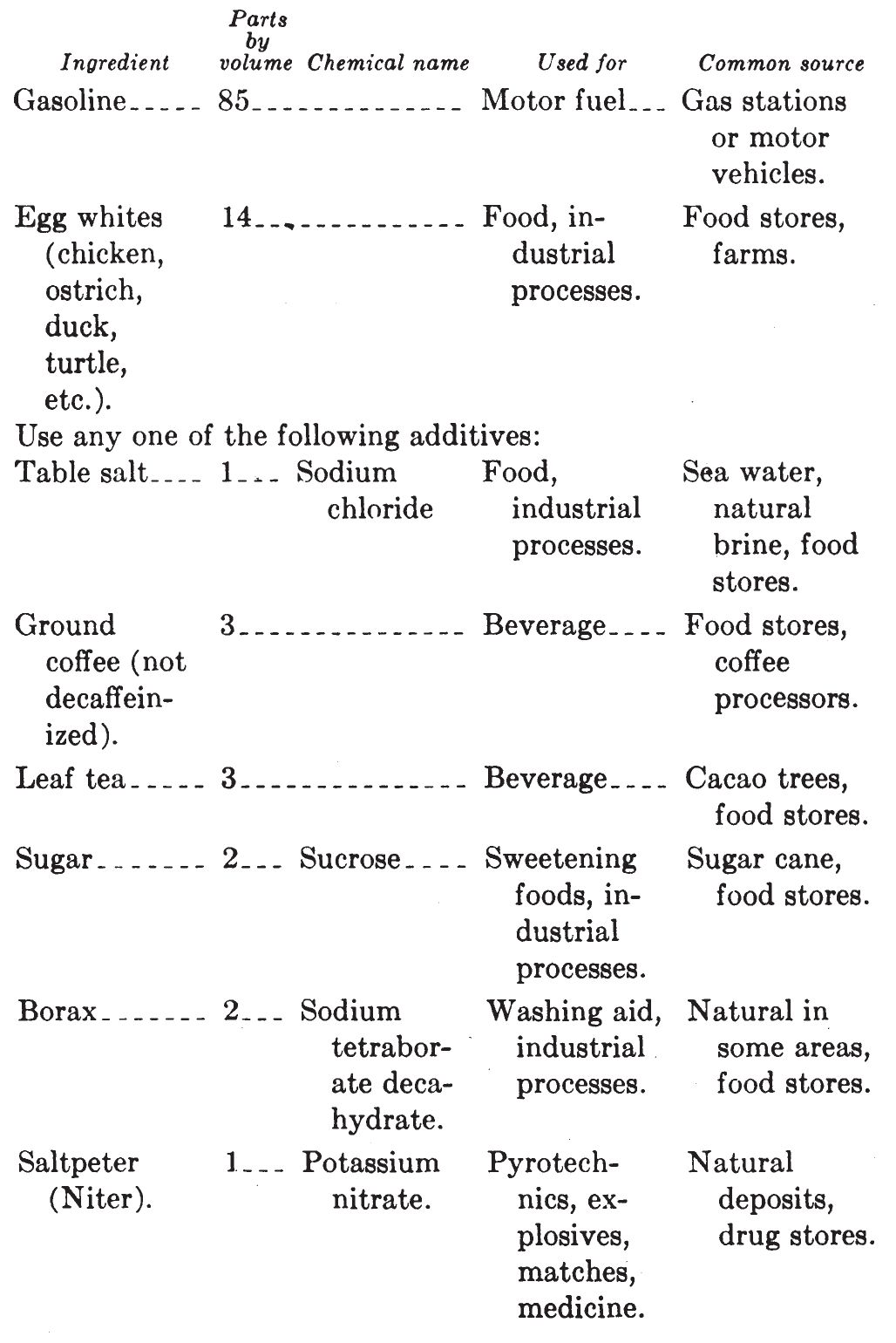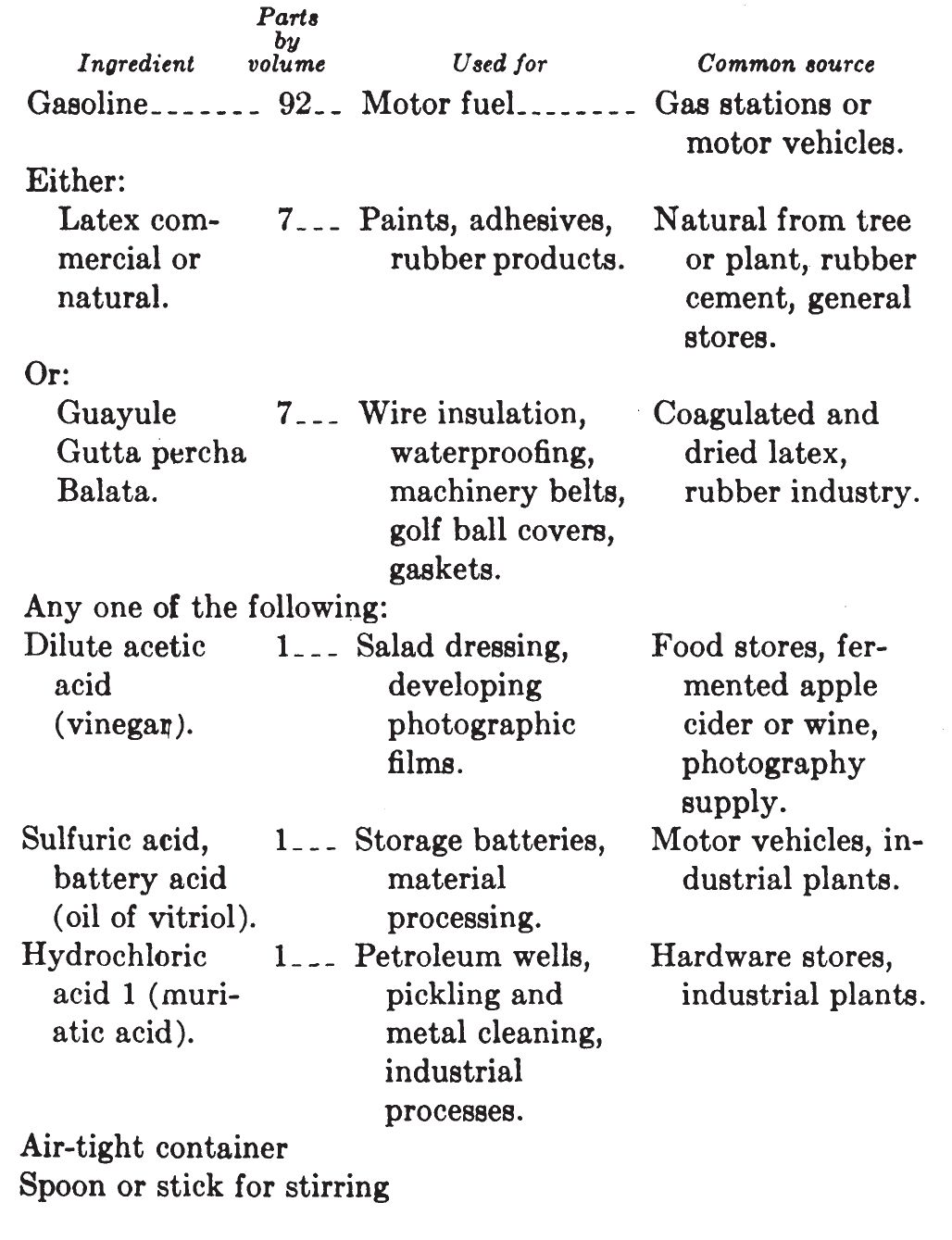Read U.S. Army Special Forces Guide to Unconventional Warfare Online
Authors: Department of the Army
U.S. Army Special Forces Guide to Unconventional Warfare (6 page)

a. Description
. See Paragraph 0303.1.
b. Material and Equipment.

Note
. Lye is also known as caustic soda or sodium hydroxide. Allow for strength of lye. If only 50% (as in Drano), use twice the amount indicated above. Methyl (wood) alcohol, isopropyl (rubbing) alcohol or antifreeze product can be substituted for whiskey, but their use produces softer gels. Potassium hydroxide (caustic potash, potassa) may be used in place of lye.
- The following can be substituted for the tallow in order of preference:
- (a)
Wool grease (lanolin) (very good)âfat extracted from sheep wool. - (
b
) Castor oil (good). - (c)
Any vegetable oil (corn, cottonseed, peanut, linseed, etc.). - (d)
Any fish oil. - (e)
Butter or oleo margarine.
- (a)
- When using substitutes (1)
(c)
and
(e)
above, it will be necessary to double the recommended amount of fat and of the lye solution for satisfactory thickening.
c. Preparation.
- Measure out the appropriate amount of gasoline and place in a clean container.
Caution:
Keep material away from open flames. - Add the tallow to the gasoline and stir for about one-half minute to dissolve the tallow.
- Add the alcohol to the mixture.
- In another container dissolve the lye in water.
Caution:
Add lye to water slowly. Do not prepare this solution in an aluminum container. - Add the lye solution to the gasoline mixture and stir occasionally until the mixture thickens (about one-half hour).
- The mixture will thicken to a very firm butter paste in one to two days. The mixture can be thinned, if desired, by mixing in additional gasoline. Store in an air-tight container until ready to use.
d. Application
. See paragraph 0303.1.
a. Description
. See paragraph 0303.1.
b. Material and Equipment.

Note
. Lye is also known as caustic soda or sodium hydroxide. Allow for the strength of the lye. If only 50% (as in Drano), use twice the amount indicated above. Potassium hydroxide (caustic potash, potassa) may be used in place of lye.
c. Preparation.
- Dissolve the lye in water using a clean container.
Caution:
Add lye to water slowly. Do not prepare this solution in an aluminum container. - Stir gasoline and copaiba balsam in another clean container.
- Add the saturated lye solution to the gasoline mixture and stir until the gel forms. Store in an air-tight container until ready to use.
Note
. Increase the lye solution to 10 parts by volume (5 parts lye, 5 parts water) if the gasoline does not thicken.
d. Application
. See paragraph 0303.1.
a. Description.
See paragraph 0303.1.
b. Material and Equipment.

Note
. Methyl (wood) or isoprophyl (rubbing) alcohols can be substituted for the ethyl alcohol. When a stronger alcohol (150 proof) or one of the dry alcohol substitutes is used, add an amount of water to make the concentration 50% by volume. (The
percent
alcohol is equal to ½ of the
proof
â150 proof is 75% alcohol.)
- Unless the word
soap
actually appears somewhere on the container or wrapper (at retail store level), a washing compound may be assumed to be a synthetic detergent. Soaps react with mineral salts in hard water to form a sticky insoluble scum while synthetic detergents do not. Synthetic detergents cannot be used. - The following is a list of commercially available soap products (at retail store level):
Name Manufacturer Ivory Snow Proctor and Gamble Ivory Flakes Proctor and Gamble Lux Flakes Lever Brothers Chiffon Flakes Armour Palmolive Bar Soap Colgate-Palmolive Sweetheart Bar Soap Manhattan Soap Company Octagon Bar Soap Colgate-Palmolive - Home prepared bar soaps may be used in place of purchased bar soaps.
c. Preparation.
- Measure out the appropriate amount of gasoline and place in a clean container.
Caution:
Keep material away from open flames. - Add the alcohol to the gasoline.
- Add the soap powder to the gasoline-alcohol mixture, and stir occasionally until the mixture thickens (about 15 minutes).
- The mixture will thicken to a very firm butter paste in one to two days. It can be thinned, if desired, by mixing in additional gasoline. Store in an air-tight container until ready to use.
d. Application.
See paragraph 0303.1.
a. Description. See paragraph 0303.1.
b. Material and Equipment.


c. Preparation.
- Separate the egg white from the yolk as follows:
- (a)
Method 1.
Crack the egg at approximately the center. Allow the egg white to drain into a clean container. When most of the egg white has drained off, flip the yellow egg yolk from one-half shell to the other, each time allowing the egg white to drain into the container. Transfer the egg white to a capped jar for storage or directly into the container being used for the gelled flame fuel. Discard the egg yolk. Repeat the process with each egg. Do not get the yellow egg yolk mixed into the egg white. If egg yolk gets into the egg white, discard the egg. - (
b
)
Method 2.
Crack the egg and transfer (CAREFULLY SO AS TO AVOID BREAKING THE YOLK) the egg to a shallow dish. Tilt the dish slowly and pour off the egg white into a suitable container while holding back the yellow egg yolk with a flat piece of wood, knife blade, or fingers. Transfer the egg white to a capped jar for storage or directly to the container being used for the gelled flame fuel. Discard the egg yolk. Repeat the process with each egg being careful not to get yellow egg yolk mixed in with the egg white. If egg yolk gets into egg white, discard the egg and wash the dish.
- (a)
- Store egg white in an ice box, refrigerator, cave, cold running stream, or other cool area until ready to prepare the gelled flame fuel.
- Pour the egg white into a clean container.
- Add the gasoline.
Caution:
Keep material away from open flames. - Add the table salt (or one of its substitutes) and stir until the gel forms (about 5â10 minutes). Use within 24 hours. Thicker gelled flame fuels can be obtained byâ
- (a)
Reducing the gasoline content to 80 parts by volume (NO LOWER); or - (b)
Putting the capped jars in hot (65° C., 149° F.) water for ½ hour and then letting them cool to ambient temperature. (DO NOT HEAT THE GELLED FUEL CONTAINING COFFEE.)
- (a)
d. Application.
See paragraph 0303.1.
a.
Description
. See paragraph 0303.1.
b. Material and Equipment.

Caution:
Sulfuric acid and hydrochloric acid will burn skin and ruin clothing. The fumes will irritate nose passages, lungs and eyes. Wash with large quantities of water upon contact.
c. Preparation.
- Commercial rubber latex may be used without further treatments before adding it to gasoline.
- Natural rubber latex will coagulate (form lumps) as it comes from the plant. Strain off the thick part for use in flame fuel. If the rubber latex does not form lumps, add a small amount of acid to coagulate the latex and use the rubbery lump for gelling. It is best to air-dry the wet lumps before adding them to gasoline.
- (a)
Using commercial rubber latex.- 1
. Place the latex and the gasoline in the container to be used for the gelled gasoline and stir.
Caution:
Keep material away from open flames.- 2
. Add the vinegar (or other acid) to the liquid in the container and stir again until the gel forms. Store in an air-tight container until ready to use.
Note
. Use gelled gasoline as soon as possible because it becomes thinner on standing. If the gel is too thin, reduce the gasoline content (but not below 85% by volume).- 3
. Natural rubber latex coagulates readily. If acids are not available, use one volume of acid salt (alum, sulfates and chlorides other than sodium and potassium). The formic acid content of crushed red ants will coagulate natural rubber latex.
- 1
- (b)
Using natural rubber latex.80 parts by volume of gasoline.
20 parts by volume of coagulated or dried rubber.
Let the rubber lump soak in the gasoline in a closed container two or three days until a gelled mass is obtained. Prepare the gelled gasoline using the above formulation. This gelled gasoline should be used as soon as possible after it has thickened sufficiently.
- (a)
d. Application.
See paragraph 0303.1.
